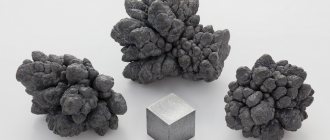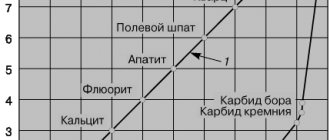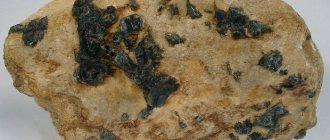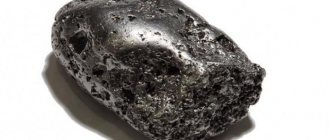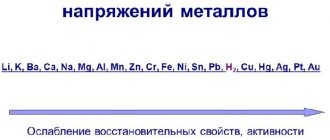Interaction of aluminum with simple substances
with oxygen
When absolutely pure aluminum comes into contact with air, aluminum atoms located in the surface layer instantly interact with oxygen in the air and form a thin, tens of atomic layers thick, durable oxide film of Al2O3 composition, which protects aluminum from further oxidation. It is also impossible to oxidize large samples of aluminum even at very high temperatures. However, fine aluminum powder burns quite easily in a burner flame:
with halogens
Aluminum reacts very vigorously with all halogens. Thus, the reaction between mixed aluminum and iodine powders occurs already at room temperature after adding a drop of water as a catalyst. Equation for the interaction of iodine with aluminum:
Aluminum also reacts with bromine, which is a dark brown liquid, without heating. Simply add a sample of aluminum to liquid bromine: a violent reaction immediately begins, releasing a large amount of heat and light:
The reaction between aluminum and chlorine occurs when heated aluminum foil or fine aluminum powder is added to a flask filled with chlorine. Aluminum burns effectively in chlorine according to the equation:
with sulfur
When heated to 150-200 o C or after igniting a mixture of powdered aluminum and sulfur, an intense exothermic reaction begins between them with the release of light:
- aluminum sulfide
with nitrogen
When aluminum reacts with nitrogen at a temperature of about 800 o C, aluminum nitride is formed:
with carbon
At a temperature of about 2000 o C, aluminum reacts with carbon and forms aluminum carbide (methanide), containing carbon in the -4 oxidation state, as in methane.
Interaction of aluminum with complex substances
with water
As mentioned above, a stable and durable oxide film of Al2O3 prevents aluminum from oxidizing in air. The same protective oxide film makes aluminum inert towards water. When removing the protective oxide film from the surface by methods such as treatment with aqueous solutions of alkali, ammonium chloride or mercury salts (amalgiation), aluminum begins to react vigorously with water to form aluminum hydroxide and hydrogen gas:
with metal oxides
After igniting a mixture of aluminum with oxides of less active metals (to the right of aluminum in the activity series), an extremely violent, highly exothermic reaction begins. Thus, in the case of interaction of aluminum with iron (III) oxide, a temperature of 2500-3000 o C develops. As a result of this reaction, high-purity molten iron is formed:
This method of obtaining metals from their oxides by reduction with aluminum is called aluminothermy or aluminothermy.
with non-oxidizing acids
The interaction of aluminum with non-oxidizing acids, i.e. with almost all acids, except concentrated sulfuric and nitric acids, leads to the formation of an aluminum salt of the corresponding acid and hydrogen gas:
2Al 0 + 6H + = 2Al 3+ + 3H2 0 ;
with oxidizing acids
-concentrated sulfuric acid
The interaction of aluminum with concentrated sulfuric acid under normal conditions and at low temperatures does not occur due to an effect called passivation. When heated, the reaction is possible and leads to the formation of aluminum sulfate, water and hydrogen sulfide, which is formed as a result of the reduction of sulfur, which is part of sulfuric acid:
Read also: Forged plant pots on the wall
Such a deep reduction of sulfur from the oxidation state +6 (in H2SO4) to the oxidation state -2 (in H2S) occurs due to the very high reducing ability of aluminum.
- concentrated nitric acid
Under normal conditions, concentrated nitric acid also passivates aluminum, which makes it possible to store it in aluminum containers. Just as in the case of concentrated sulfuric acid, the interaction of aluminum with concentrated nitric acid becomes possible with strong heating, and the reaction predominantly occurs:
- dilute nitric acid
The interaction of aluminum with diluted nitric acid compared to concentrated nitric acid leads to products of deeper nitrogen reduction. Instead of NO, depending on the degree of dilution, N2O and NH4NO3 can be formed:
with alkalis
Aluminum reacts both with aqueous solutions of alkalis:
and with pure alkalis during fusion:
In both cases, the reaction begins with the dissolution of the protective film of aluminum oxide:
In the case of an aqueous solution, aluminum, cleared of the protective oxide film, begins to react with water according to the equation:
The resulting aluminum hydroxide, being amphoteric, reacts with an aqueous solution of sodium hydroxide to form soluble sodium tetrahydroxoaluminate:
Aluminum is a reactive metal, but a strong oxide film determines its resistance under normal conditions. In almost all chemical reactions, aluminum exhibits reducing properties.
- Interaction with non-metals
It interacts with oxygen only in a finely divided state at high temperatures:
the reaction is accompanied by a large release of heat.
Above 200°C it reacts with sulfur to form aluminum sulfide:
At 500°C – with phosphorus, forming aluminum phosphide:
At 800°C it reacts with nitrogen, and at 2000°C – with carbon, forming nitride and carbide:
It reacts with chlorine and bromine under normal conditions, and with iodine when heated, in the presence of water as a catalyst:
Does not interact directly with hydrogen.
With metals it forms alloys that contain intermetallic compounds - aluminides, for example, CuAl2, CrAl7, FeAl3, etc.
Interaction with water
Aluminum purified from the oxide film vigorously interacts with water:
As a result of the reaction, slightly soluble aluminum hydroxide is formed and hydrogen is released.
Interaction with acids
Easily reacts with dilute acids, forming salts:
8Al + 30HNO3 = 8Al(NO3)3 + 3N2O + 15H2O (nitrogen and ammonium nitrate can also be the product of nitric acid reduction).
It does not react with concentrated nitric and sulfuric acids at room temperature; when heated, it reacts to form a salt and the acid reduction product:
Interaction with alkalis
Aluminum is an amphoteric metal; it reacts easily with alkalis:
in solution to form sodium tetrahydroxodiaquaaluminate:
when fused to form aluminates:
Recovery of metals from oxides and salts
Aluminum is an active metal, capable of displacing metals from their oxides. This property of aluminum has found practical application in metallurgy:
Metals are one of the most convenient materials to process. They also have their own leaders. For example, the basic properties of aluminum have been known to people for a long time. They are so suitable for everyday use that this metal has become very popular. What are the properties of aluminum as a simple substance and as an atom, we will consider in this article.
Pages
- Home page
- BASICS OF GENERAL CHEMISTRY
- 1.1 The most important classes of inorganic substances
- 2.1 Substances. Atoms
- 2.2 Atomic sizes
- 2.3 Molecules. Chemical formulas
- 2.4 Simple and complex substances
- 2.5 Valence of elements
- 2.6 Mol. Molar mass
- 2.7 Avogadro's Law
- 2.8 Law of conservation of mass of substances
- 2.9 Derivation of chemical formulas
- 3.1 Structure of the atom. Chemical bond
- 3.2 Atomic structure
- 3.4 Structure of the electron shell of an atom
- 3.5 Periodic table of chemical elements
- 3.6 Dependency of element properties
- 3.7 Chemical bonding and structure of matter
- 3.8 Orbital hybridization
- 3.9 Donor-acceptor mechanism of formation
- 3.10 Oxidation states of elements
- 4.1 Classification of chemical reactions
- 4.2 Thermal effects of reactions
- 4.3 Rate of chemical reactions
- 4.4 Irreversible and reversible reactions
- 4.5 General classification of chemical reactions
- INORGANIC CHEMISTRY
- 5.1 Solutions. Electrolytic dissociation
- 5.2 Quantitative characteristics of the composition of solutions
- 5.3 Electrolytic dissociation
- 5.4 Dissociation of acids, bases and salts
- 5.5 Water dissociation
- 5.6 Exchange reactions in aqueous solutions of electrolytes
- 5.7 Hydrolysis of salts
- 6.1 The most important classes of inorganic substances
- 6.2 Acids, their properties and preparation
- 6.3 Amphoteric hydroxides
- 6.4 Salts, their properties and preparation
- 6.5 Genetic relationship between the most important classes
- 6.6 Concept of double salts
- 7.1 Metals and their compounds
- 7.2 Electrolysis
- 7.3 General characteristics of metals
- 7.4 Metals of the main subgroups of groups I and II
- 7.5 Aluminum
- 7.6 Iron
- 7.7 Chrome
- 7.8 The most important compounds of manganese and copper
- 8.1 Non-metals and their inorganic compounds
- 8.2 Hydrogen, its production
- 8.3 Halogens. Chlorine
- 8.4 Chalcogens. Oxygen
- 8.5 Sulfur and its most important compounds
- 8.6 Nitrogen. Ammonia. Ammonium salts
- 8.7 Nitrogen oxides. Nitric acid
- 8.8 Phosphorus and its compounds
- 8.9 Carbon and its most important compounds
- 8.10 Silicon and its most important compounds
- ORGANIC CHEMISTRY
- 9.1 Basic principles of organic chemistry. Hydrocarbons
- 9.2 Electronic effects of substituents in organic compounds
- 9.3 Saturated hydrocarbons (alkanes)
- 9.3.1 Saturated hydrocarbons. Methane
- 9.4 Concept of cycloalkanes
- 9.5 Unsaturated hydrocarbons
- 9.6 Diene hydrocarbons (alkadienes)
- 9.7 Alkynes
- 9.8 Aromatic hydrocarbons
- 9.9 Natural sources of hydrocarbons
- 10.1 Oxygen-containing organic compounds
- 10.2 Phenols
- 10.3 Aldehydes
- 10.4 Carboxylic acids
- 10.5 Esters. Fats
- 10.6 Understanding surfactants
- 10.7 Carbohydrates
- 11.1 Amines. Amino acids
- 11.2 Proteins
- 11.3 Concept of heterocyclic compounds
- 11.4 Nucleic acids
- 12.1 High molecular weight compounds
- 12.2 Synthetic fibers
History of the discovery of aluminum
For a long time, man has known the compound of the metal in question - potassium alum. It was used as a means that could swell and bind together the components of the mixture; this was also necessary in the manufacture of leather products. The existence of aluminum oxide in its pure form became known in the 18th century, in its second half. However, no pure substance was obtained.
Read also: Freezer for making soft ice cream
The scientist H. K. Ørsted was the first to isolate the metal from its chloride. It was he who treated the salt with potassium amalgam and isolated gray powder from the mixture, which was aluminum in its pure form.
Then it became clear that the chemical properties of aluminum are manifested in its high activity and strong reducing ability. Therefore, no one else worked with him for a long time.
However, in 1854, the Frenchman Deville was able to obtain metal ingots by electrolysis of the melt. This method is still relevant today. Especially mass production of valuable material began in the 20th century, when the problems of generating large amounts of electricity in enterprises were solved.
Today, this metal is one of the most popular and used in construction and the household industry.
Destruction of complex salt
Experiment No. 3. Interaction of a solution of sodium tetrahydroxoaluminate with hydrochloric acid and carbon dioxide
We will add a dilute solution of hydrochloric acid drop by drop to the sodium hydroxoaluminate solution. We observe the precipitation of aluminum hydroxide and its subsequent dissolution:
Na[Al(OH)4] + HCl = Al(OH)3¯ + NaCl + H2O
Al(OH)3+ 3HCl = AlCl3 + 3H2O
Sodium tetrahydroxyaluminate is unstable and is destroyed in an acidic environment. Let's see if weak carbonic acid destroys the complex.
We will pass carbon dioxide through a solution of sodium tetrahydroxyaluminate. Carbon dioxide, in turn, is obtained from the reaction between marble and hydrochloric acid. After some time, a suspension of water-insoluble aluminum hydroxide is formed, which does not disappear with further passage of carbon dioxide.
Na[Al(OH)4] + CO2= Al(OH)3 + NaHCO3
That is, excess carbon dioxide does not dissolve aluminum hydroxide.
Summing up the lesson
To obtain water-insoluble aluminum hydroxide, it is necessary to carry out a reaction between a solution of aluminum salt and a small amount of alkali solution (since aluminum hydroxide dissolves in excess alkali). The resulting aluminum hydroxide reacted with both alkali and acid, which means it exhibited amphoteric properties. When interacting with an alkali solution, aluminum hydroxide forms a complex salt, which is destroyed in an acidic environment.
Bibliography
- Novoshinsky I.I., Novoshinskaya N.S. Chemistry. Textbook for 10th grade general education. establishment Profile level. – M.: LLC TID “Russian Word - RS”, 2008. (§ 54)
- Kuznetsova N.E., Litvinova T.N., Levkin A.N. Chemistry: 11th grade: Textbook for general education students. establishment (profile level): in 2 parts. Part 2. M.: Ventana-Graf, 2008. (p. 110–111)
- Radetsky A.M. Chemistry. Didactic material. 10–11 grades. – M.: Education, 2011.
- Khomchenko I.D. Collection of problems and exercises in chemistry for high school. – M.: RIA “New Wave”: Publisher Umerenkov, 2008.
Additional recommended links to Internet resources
- Alchemist (Source).
- Alchemist (Source).
- Chemport (Source).
- Lidijavk.ucoz.ru (Source).
Homework
- With. 27-29 No. 5.1, 5.15, 5.25 from the collection of problems and exercises in chemistry for secondary school (Khomchenko I.D.), 2008.
- Write down the equation for the reaction that results in the formation of chromium (III) hydroxide; Use reaction equations to illustrate the amphoteric nature of this hydroxide.
General characteristics of the aluminum atom
If we characterize the element in question by its position in the periodic table, then several points can be distinguished.
- Serial number – 13.
- Located in the third small period, third group, main subgroup.
- Atomic mass – 26.98.
- The number of valence electrons is 3.
- The configuration of the outer layer is expressed by the formula 3s 2 3p 1.
- The name of the element is aluminum.
- Metallic properties are strongly expressed.
- It has no isotopes in nature; it exists only in one form, with a mass number of 27.
- The chemical symbol is AL, read as “aluminum” in formulas.
- The oxidation state is one, equal to +3.
The chemical properties of aluminum are fully confirmed by the electronic structure of its atom, because having a large atomic radius and low electron affinity, it is capable of acting as a strong reducing agent, like all active metals.
Aluminum as a simple substance: physical properties
If we talk about aluminum as a simple substance, then it is a silvery-white shiny metal. In air it quickly oxidizes and becomes covered with a dense oxide film. The same thing happens when exposed to concentrated acids.
The presence of such a feature makes products made of this metal resistant to corrosion, which, naturally, is very convenient for people. That is why aluminum is so widely used in construction. The properties of the substance are also interesting in that this metal is very light, yet durable and soft. The combination of such characteristics is not available to every substance.
There are several basic physical properties that are characteristic of aluminum.
- High degree of malleability and ductility. Light, strong and very thin foil is made from this metal, and it is also rolled into wire.
- Melting point – 660 0 C.
- Boiling point – 2450 0 C.
- Density – 2.7 g/cm3.
- The crystal lattice is volumetric face-centered, metal.
- Type of connection – metal.
The physical and chemical properties of aluminum determine the areas of its application and use. If we talk about everyday aspects, then the characteristics we have already discussed above play a big role. As a lightweight, durable and anti-corrosion metal, aluminum is used in aircraft and shipbuilding. Therefore, these properties are very important to know.
Chemical properties of aluminum
From a chemical point of view, the metal in question is a strong reducing agent that is capable of exhibiting high chemical activity while being a pure substance. The main thing is to remove the oxide film. In this case, activity increases sharply.
The chemical properties of aluminum as a simple substance are determined by its ability to react with:
It does not interact with water under normal conditions. In this case, of the halogens, without heating, it reacts only with iodine. Other reactions require temperature.
Examples can be given to illustrate the chemical properties of aluminum. Equations of reactions of interaction with:
- acids – AL + HCL = AlCL3 + H2;
- alkalis – 2Al + 6H2O + 2NaOH = Na[Al(OH)4] + 3H2;
- halogens – AL + Hal = ALHal3;
- gray – 2AL + 3S = AL2S3.
Read also: Tenoning cutter for hand router
In general, the most important property of the substance in question is its high ability to restore other elements from their compounds.
Chemical properties of complex salts (using the example of aluminum and zinc compounds)
As part of the Unified State Examination program in chemistry, one should learn the chemical properties of such complex compounds of aluminum and zinc as tetrahydroxoaluminates and tetrahydroxoaluminates.
Tetrahydroxoaluminates and tetrahydroxozincates are salts whose anions have the formulas [Al(OH)4]- and [Zn(OH)4]2-, respectively. Let's consider the chemical properties of such compounds using sodium salts as an example:
These compounds, like other soluble complex compounds, dissociate well, while almost all complex ions (in square brackets) remain intact and do not dissociate further:
The action of an excess of strong acid on these compounds leads to the formation of two salts:
When they are exposed to a lack of strong acids, only the active metal passes into the new salt. Aluminum and zinc in the hydroxides precipitate:
Precipitation of aluminum and zinc hydroxides with strong acids is not a good choice, since it is difficult to add the strictly required amount of strong acid without dissolving part of the precipitate. For this reason, carbon dioxide is used, which has very weak acidic properties and therefore is not able to dissolve the hydroxide precipitate:
In the case of tetrahydroxoaluminate, hydroxide precipitation can also be carried out using sulfur dioxide and hydrogen sulfide:
In the case of tetrahydroxozincate, precipitation with hydrogen sulfide is impossible, since zinc sulfide precipitates instead of zinc hydroxide:
When evaporating solutions of tetrahydroxozincate and tetrahydroxoaluminate followed by calcination, these compounds transform into zincate and aluminate, respectively:
Distribution in nature
In terms of prevalence among other metal elements, aluminum ranks first. It is contained in the earth's crust 8.8%. If we compare it with non-metals, then its place will be third, after oxygen and silicon.
Due to its high chemical activity, it is not found in pure form, but only as part of various compounds. For example, there are many known ores, minerals, and rocks that contain aluminum. However, it is extracted only from bauxite, the content of which in nature is not very high.
The most common substances containing the metal in question:
- feldspars;
- bauxite;
- granites;
- silica;
- aluminosilicates;
- basalts and others.
In small quantities, aluminum is necessarily found in the cells of living organisms. Some species of club mosses and marine inhabitants are capable of accumulating this element inside their bodies throughout their lives.
Receipt
The physical and chemical properties of aluminum make it possible to obtain it only in one way: by electrolysis of a melt of the corresponding oxide. However, this process is technologically complex. The melting point of AL2O3 exceeds 2000 0 C. Because of this, it cannot be subjected to electrolysis directly. Therefore, proceed as follows.
- Bauxite is mined.
- They are cleaned of impurities, leaving only aluminum oxide.
- Then the cryolite is melted.
- Oxide is added there.
- This mixture is electrolyzed and pure aluminum and carbon dioxide are obtained.
The product yield is 99.7%. However, it is possible to obtain even purer metal, which is used for technical purposes.
Production and use of aluminum
Aluminum is quite difficult to isolate from natural compounds by chemical means, which is explained by the high strength of bonds in aluminum oxide; therefore, for the industrial production of aluminum, electrolysis of a solution of alumina Al2O3 in molten cryolite Na3AlF6 is used. As a result of the process, aluminum is released at the cathode, and oxygen is released at the anode:
2Al2O3 → 4Al + 3O2
The starting raw material is bauxite. Electrolysis occurs at a temperature of 1000°C: the melting point of aluminum oxide is 2500°C - it is not possible to carry out electrolysis at this temperature, so aluminum oxide is dissolved in molten cryolite, and only then the resulting electrolyte is used in electrolysis to produce aluminum.
Application of aluminum:
- aluminum alloys are widely used as structural materials in automobile, aircraft, and shipbuilding: duralumin, silumin, aluminum bronze;
- in the chemical industry as a reducing agent;
- in the food industry for the production of foil, tableware, packaging material;
- for making wires, etc.
Top of page
Application
The mechanical properties of aluminum are not so good that it can be used in its pure form. Therefore, alloys based on this substance are most often used. There are many of these, you can name the most basic ones.
- Duralumin.
- Aluminum-manganese.
- Aluminum-magnesium.
- Aluminum-copper.
- Silumins.
- Avial.
Their main difference is, naturally, third-party additives. All of them are based on aluminum. Other metals make the material more durable, corrosion-resistant, wear-resistant and easy to process.
There are several main areas of application of aluminum, both in pure form and in the form of its compounds (alloys).
- For the production of wire and foil used in everyday life.
- Making dishes.
- Aircraft manufacturing.
- Shipbuilding.
- Construction and architecture.
- Space industry.
- Creation of reactors.
Together with iron and its alloys, aluminum is the most important metal. It was these two representatives of the periodic table that found the most extensive industrial application in human hands.
Properties of aluminum hydroxide
Hydroxide is the most common compound that aluminum forms. Its chemical properties are the same as those of the metal itself - it is amphoteric. This means that it is capable of exhibiting a dual nature, reacting with both acids and alkalis.
Aluminum hydroxide itself is a white gelatinous precipitate. It is easily obtained by reacting aluminum salts with alkali or ammonium hydroxide. When reacting with acids, this hydroxide gives the usual corresponding salt and water. If the reaction occurs with an alkali, then hydroxo complexes of aluminum are formed, in which its coordination number is 4. Example: Na[Al(OH)4] – sodium tetrahydroxoaluminate.
Nomenclature
Naming for the various forms of aluminum hydroxide is controversial and no universal standard exists. All four polymorphs have the chemical composition aluminum trihydroxide (one aluminum atom attached to three hydroxide groups).
Gibbsite is also known as hydrargillite, named after the Greek words for water ( hydra
) and clay (
argylles
).
The first compound, called hydrargillite,
was thought to be aluminum hydroxide, but was later discovered to be aluminum phosphate;
Despite this, both gibbsite
and
hydrargillite
are used to refer to the same polymorphism of aluminum hydroxide, with
gibbsite
being used most often in the United States and
hydrargillite
being used more often in Europe.
In 1930, it was referred to as α-alumina trihydrate
to contrast it with bayerite, which was called
β-alumina trihydrate
(alpha and beta designations were used to differentiate the more and less common forms respectively). In 1957, a symposium on alumina nomenclature attempted to develop a universal standard, resulting in gibbsite being designated γ Al(OH)3, bayerite becoming alpha-Al(OH)3, and norstrandite being designated Al(OH)3. Based on their crystallographic properties, the proposed nomenclature and designation for gibbsite to be α-Al(OH)3, bayerite to be designated beta-Al(OH)3, and both nordstrandite and doyleite to be designated Al(OH)3. According to this assignment, alpha and beta prefixes refer to hexagonal, close-packed structures and altered or anhydrous polymorphisms, respectively, without differentiating between nordstrand and doyleite.

